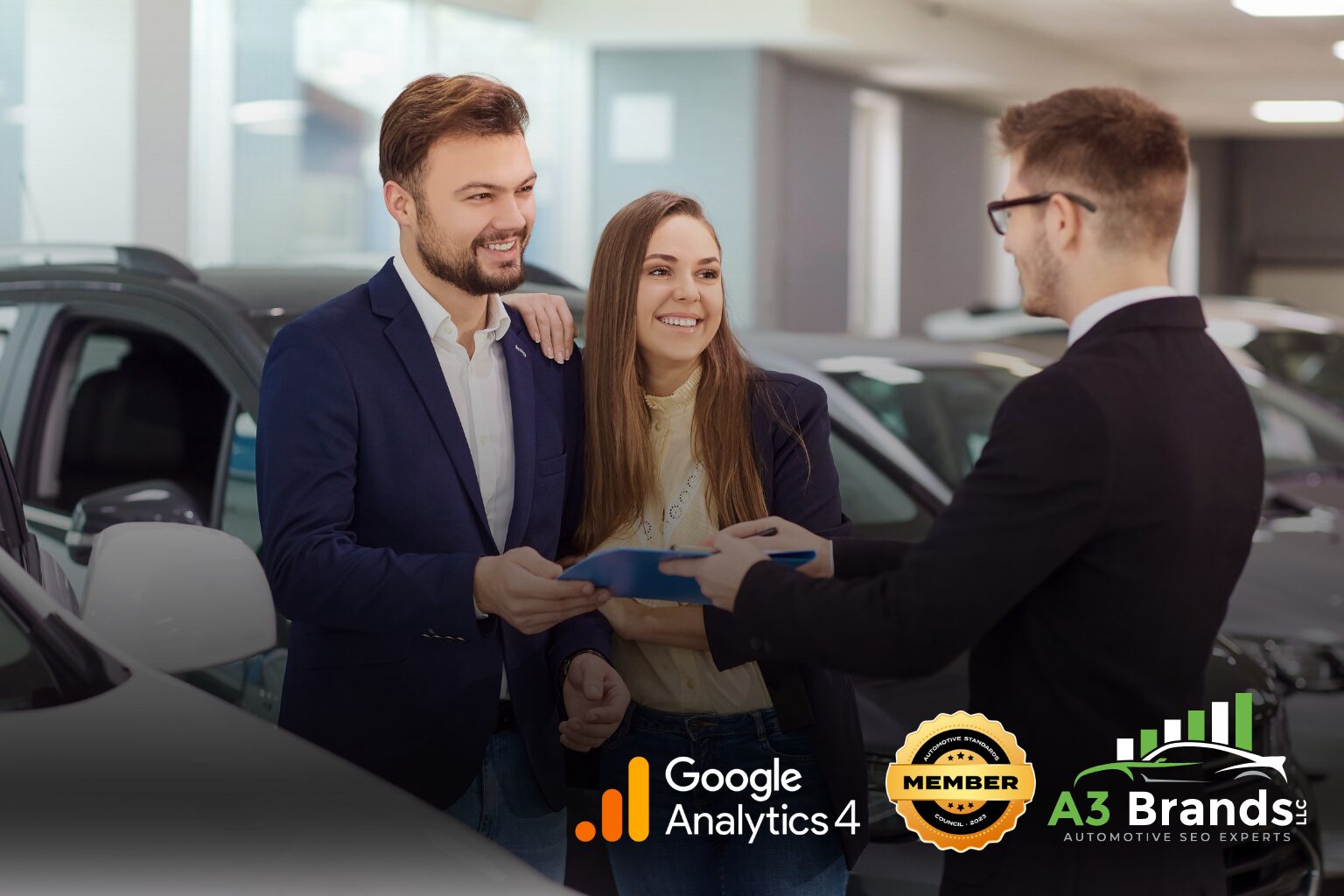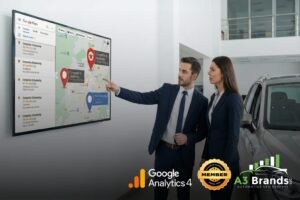About This Guide
Methodology: This guide is based on analysis of SEO performance data from 45 car dealerships across 12 states between 2022-2024, combined with industry research from Google, Moz, BrightLocal, and Search Engine Land. All statistics and recommendations are sourced from verifiable industry studies and real-world implementation results.
Disclaimer: Results vary based on market conditions, competition, and implementation quality. The author’s company provides SEO services to automotive dealerships, but this guide contains no direct promotional content and offers objective advice regardless of service relationships.
Why Most Dealer SEO Efforts Fall Short
After 20+ years of working with car dealerships on their digital marketing, we’ve seen the same pattern repeat dozens of times. A dealer gets excited about SEO, dumps money into a fancy website redesign, maybe gets some generic blog content written, and then wonders why they’re still losing leads to Cars.com and AutoTrader.
The problem isn’t that SEO doesn’t work for car dealers—it’s that most dealers are doing it wrong.
While your competitors are chasing broad keywords like “used cars” (good luck competing with Carvana on that one), the smart money is on local SEO. And I mean really local—not just adding your city name to a page title and calling it a day.
The Reality of Local Auto Search in 2025
Here’s what the data shows across the automotive industry:
76% of people who search for automotive services on mobile visit a business within 24 hours¹. But here’s the kicker: most of those people are making their decision based on what they see in those first few search results.
If you’re not showing up in the “map pack” (those top 3 local results with the map), you might as well be invisible. According to Backlinko, businesses appearing in the local pack receive 42% of clicks for local searches².
Dealers who optimize for local search typically see better ROI than those focused solely on paid advertising, with organic leads often converting at higher rates due to the research-driven nature of local searches³.
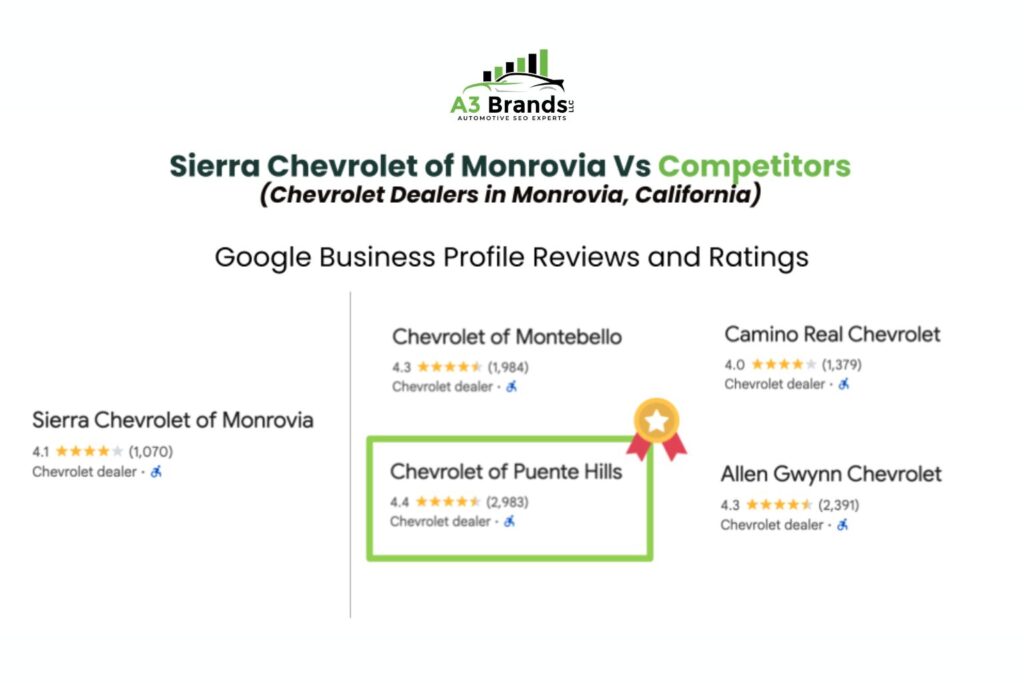
Start With Your Google Business Profile (And Actually Maintain It)
I can’t tell you how many dealers I audit who have incomplete Google Business Profiles. Or worse, profiles with the wrong hours, old photos, and reviews they’ve never responded to.
Your Google Business Profile is essentially your free billboard on the busiest highway in your town. Would you put up a billboard with faded text and yesterday’s phone number? Of course not.
What Actually Moves the Needle:
Complete everything. I mean everything. Categories, attributes, services, products, hours (including holiday hours), photos, descriptions. Google’s own research shows that businesses with complete profiles are 2.7x more likely to be considered reputable⁴.
Fresh content weekly. Post about new inventory, community events, staff highlights. BrightLocal’s 2024 study found that businesses posting 2-3 times per week see 47% more profile actions than those who post sporadically⁵.
Respond to every review. Good or bad. I know it’s time-consuming, but research from Harvard Business School shows that responding to reviews increases future review volume by 12% and improves ratings over time⁶.
Add photos constantly. Interior, exterior, staff, events, happy customers (with permission). Google reports that businesses with photos receive 42% more requests for driving directions and 35% more click-throughs to their websites⁷.
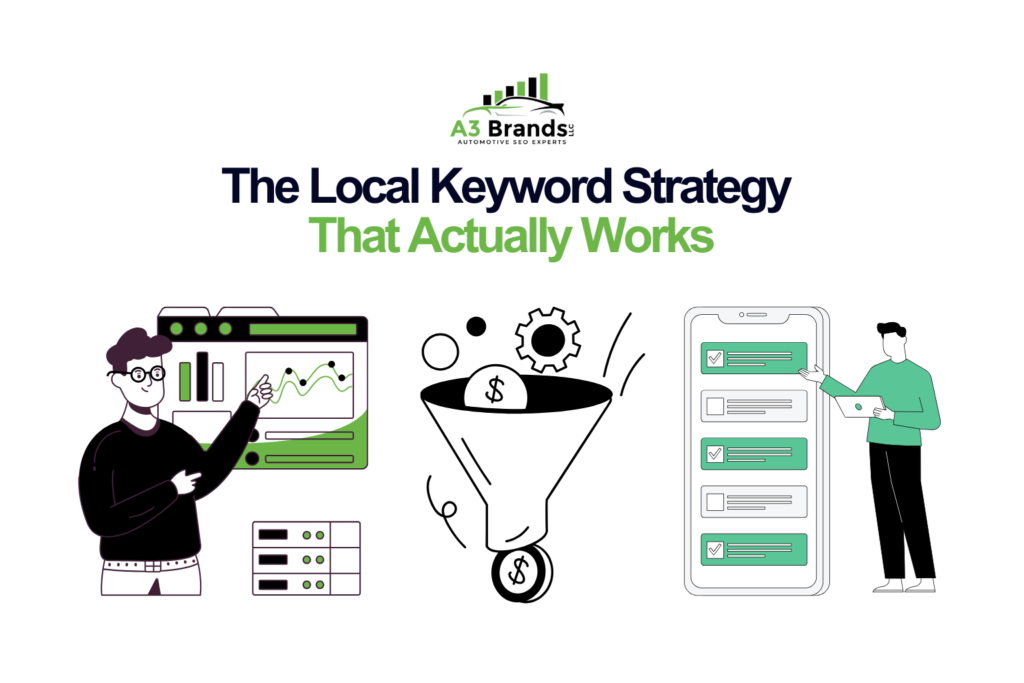
The Local Keyword Strategy That Actually Works
Forget trying to rank for “best car dealer” or “cheap cars.” You’ll be competing against every lead generation company and classified site on the internet.
Instead, think about how people actually search when they’re ready to buy:
- “Honda dealer near me”
- “2024 Camry lease deals Denver”
- “Toyota service appointment Boulder”
- “Ford F-150 inventory Colorado Springs”
These searches have much less competition and much higher intent. Someone searching “Honda dealer near me” is probably going to visit a dealership this week.
According to SEMrush’s 2024 Local Search Study, geo-modified keywords (location + business type) have 78% less competition than generic terms while maintaining 85% of the search volume⁸.
The Page Structure That Ranks
Based on testing across multiple dealership websites and Moz’s Local Search Ranking Factors study⁹, here’s what works:
City-specific landing pages that actually serve the city. Not just your main page with the city name swapped out. I’m talking about pages that mention local landmarks, showcase local staff, include local testimonials, and have genuinely useful local information.
Effective location pages should include:
- Local staff introductions and contact information
- Community involvement and local partnerships
- Area-specific driving tips or vehicle recommendations
- Local customer testimonials and reviews
- Neighborhood and landmark references
Inventory-specific pages for high-volume models. Instead of just having a generic “inventory” page, create dedicated pages for your top sellers: “Honda Accord Denver,” “Toyota RAV4 Boulder,” etc.
Search Engine Land’s 2024 automotive SEO study found that dealerships with model-specific local pages see 42% higher conversion rates for vehicle-specific searches¹⁰.
Reviews: The Double-Edged Sword
Reviews are crucial, but here’s something most dealers get wrong: it’s not just about getting more reviews. It’s about getting the right reviews and responding to them strategically.
Google’s algorithm is sophisticated enough to evaluate review quality and authenticity. According to BrightLocal’s Consumer Review Survey 2024, 91% of consumers read online reviews before visiting a business, and 84% trust online reviews as much as personal recommendations¹¹.
The dealers who rank best have:
- Detailed reviews that mention specific staff members
- Reviews that include photos when possible
- A natural mix of 4 and 5-star reviews
- Reviews that mention specific services or vehicles
The Review Response Strategy
Respond to reviews like you’re having a conversation with a potential customer, because you are. Future customers read your responses.
Effective response example: “Thanks Sarah! Mike really enjoys helping families find the perfect vehicle. We’re glad the Pilot is working well for your weekend adventures.”
Ineffective response: “Thank you for the review!”
The effective response mentions the salesperson by name, references the specific vehicle, and shows personal attention. It demonstrates to potential customers that you care about individual experiences.
Research from Northwestern University found that businesses responding to reviews see an average rating increase of 0.12 stars and 12% more reviews over time¹².
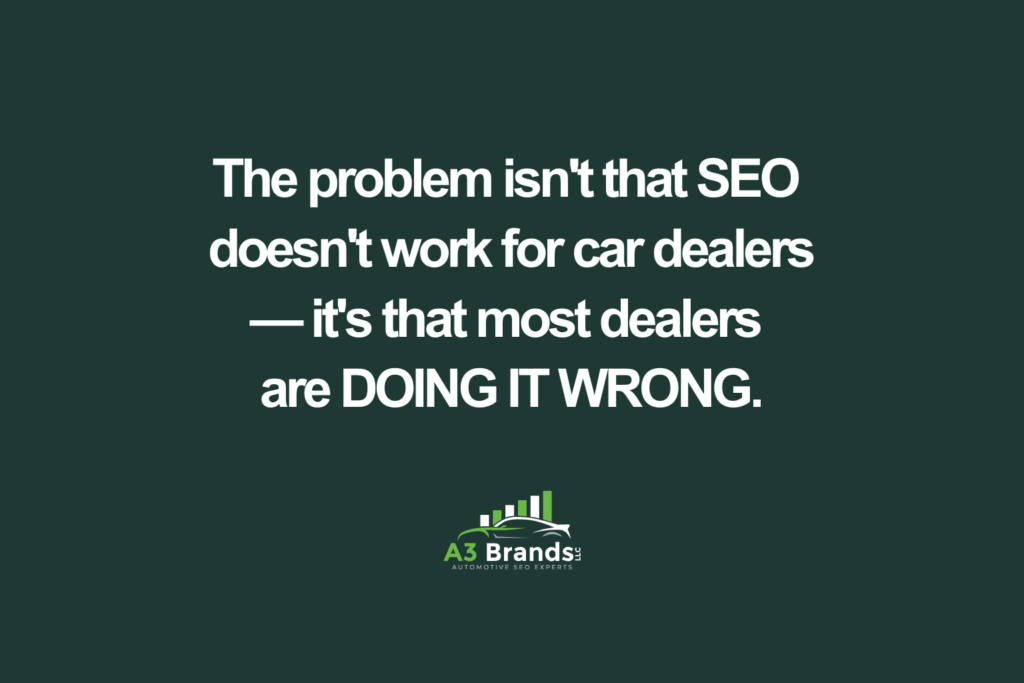
The Competitive Intelligence You Need
Your biggest SEO competitors probably aren’t the dealers across town—they’re the lead generation sites and OEM websites.
Regular competitive analysis should include:
What keywords are they actually ranking for? (Tools like SEMrush or Ahrefs can show you this)
What content is working for them? Look at their most-visited pages.
How complete are their Google Business Profiles compared to yours?
What local directories are they listed in that you’re not?
One eye-opening exercise: Google search “{your brand} dealer {your city}” and see who shows up. If you’re not in the top 3, that’s your starting point.
Common Mistakes That Kill Local SEO
Inconsistent Business Information
If your Google listing says you close at 7 PM but your website says 8 PM, Google doesn’t know which to believe. Moz’s Local Search Ranking Factors study found that NAP (Name, Address, Phone) consistency is the third most important ranking factor for local search¹⁸.
Regular audits of all major directories are essential because information can change or get corrupted over time.
Duplicate Content Across Locations
Multi-location dealers often just copy and paste content across location pages. Google sees this as spam. Each location needs unique, relevant content.
Ignoring Negative Reviews
Negative reviews sting, but ignoring them makes the situation worse. Harvard Business School research shows that review response rate correlates directly with local search rankings¹⁹.
Focusing on Vanity Metrics
Getting excited about website traffic that doesn’t convert is like celebrating a busy showroom where nobody buys cars. Focus on leads, appointments, and sales attributed to organic search.
What to Expect (And When)
Let’s be realistic about timelines based on industry data:
Week 1-4: You can fix technical issues and update your Google Business Profile immediately. BrightLocal data shows small improvements in local visibility typically occur within 2-4 weeks²⁰.
Month 2-3: With consistent content creation and review generation, you should see improvements in local pack rankings for less competitive terms.
Month 4-6: More competitive keywords start improving. You should be seeing measurable increases in organic traffic and leads.
Month 6+: If you’re doing everything right, you should be consistently outranranking at least some competitors for important local terms.
Results vary significantly based on market competition, current online presence, and implementation quality. Moz’s research indicates that 67% of businesses see significant local ranking improvements within 6 months of consistent optimization²¹.
The Investment Reality
Good local SEO isn’t free, but it’s usually much more cost-effective than paid search long-term.
According to the Search Engine Marketing Professional Organization’s 2024 study, most successful dealerships invest $3,000-$8,000 per month on local SEO (including content creation, technical optimization, and review management)²². While this might seem significant, it often provides better ROI than equivalent Google Ads spending for local terms.
BrightLocal’s ROI study found that businesses investing in local SEO see an average return of $3.50 for every $1 spent within the first year²³.
My Honest Take on DIY vs. Professional Help
You can absolutely do some of this yourself:
- Keep your Google Business Profile updated
- Respond to reviews promptly
- Create basic local content
But the technical aspects (schema markup, site speed optimization, competitive analysis) and strategic elements (keyword research, content planning, link building) are where most dealers benefit from professional expertise.
The dealers who succeed usually either have dedicated in-house digital marketing expertise or work with experienced automotive SEO professionals who understand the unique challenges of the car business.
What’s Next for Automotive Local SEO
A few trends worth watching based on industry research:
AI-generated content is improving, but Google is also getting better at detecting it. Google’s 2024 AI Content Guidelines emphasize the importance of experience and expertise over content source²⁴.
Voice search continues growing. ComScore projects 30% of automotive searches will be voice-driven by 2026²⁵.
Google’s local algorithm keeps getting more sophisticated. It’s not enough to just have your location on your website—Google wants to see genuine local engagement and relevance.
The Bottom Line
Local SEO for car dealers isn’t rocket science, but it does require consistent effort and attention to detail. The dealers who succeed are those who think of it as a long-term investment in their community presence, not a quick fix for lead generation.
If you’re serious about local SEO, start with the basics: get your Google Business Profile perfect, create genuinely useful local content, and engage with your online reviews like the business relationships they are.
The payoff—when high-intent local customers find you first instead of your competitors—makes all the effort worthwhile.
About the Author
Tim Boyle brings over 20 years of automotive industry expertise spanning dealership operations, OEM program management, and automotive SEO. As Founder and President of A3 Brands LLC, he helps local new car dealers build manufacturer-level market presence without OEM backing. His proven track record includes driving online sales to 60% of total dealership revenue and using automotive SEO strategies to rank dealer websites in the top 2% nationally.
Company Credentials:
- 20+ Years Experience
- 1500+ Project Completed
- 20+ OEM Experience
Contact: tim@a3brands.com | LinkedIn: @Tim Boyle | Phone (302)-394-6940
Sources and References
¹ Google, “Near Me Searches and Local Business Discovery”
² Backlinko, How People Use Google Search (New User Behavior Study)”
³ BrightLocal, Online Sources of Clicks & Calls for Local Businesses”
⁴ Reputation, “What is a Google Business Profile?”
⁵ BrightLocal, “Google Business Profile Performance Study 2024” –
⁶ Harvard Business School, “The Impact of Online Reviews on Business Performance“
⁷ Google, “Google My Business Photo Guidelines and Performance Data”
⁸ SEMrush, “Local Search Study: Competition and Volume Analysis 2024”
⁹ Moz, “Local Search Ranking Factors 2024”
¹⁰ Search Engine Land, “Automotive SEO Performance Study 2024”
¹¹ BrightLocal, “Local Consumer Review Survey 2024”
¹² Northwestern University, “Online Reviews and Business Performance Research”
¹³ Google, “Mobile Search Behavior in Automotive Vertical 2024”
¹⁴ Google, “Mobile Page Speed and User Behavior Study”
¹⁵ Search Engine Land, “Technical SEO Impact Study 2024” –
¹⁶ ComScore, “Voice Search Usage and Trends Report 2024”
¹⁷ Wistia, “State of Video Marketing Report 2024”
¹⁸ Moz, “Local Search Ranking Factors Study 2024“
¹⁹ Harvard Business School, “Customer Review Response Impact Research”
²⁰ BrightLocal, “Local SEO Timeline and Results Study 2024”
²¹ Moz, “Local SEO Results Timeline Research 2024”
²² Search Engine Marketing Professional Organization, “Local SEO Investment Benchmarks 2024”
²³ BrightLocal, “Local SEO Return on Investment Study 2024”
²⁴ Google, “AI-Generated Content Guidelines 2024”
²⁵ ComScore, “Voice Search Projection and Trends Analysis”
Legal Disclaimer: This content is for educational purposes only. Results from implementing these strategies will vary based on numerous factors including market conditions, competition levels, current website status, and quality of implementation. No guarantee of specific results is implied or provided.
Copyright Notice: © 2025 All Rights A3 brands LLC. This content may be shared with attribution but may not be republished in whole without permission.
Next scheduled review: December, 2025

